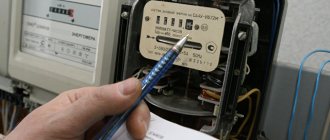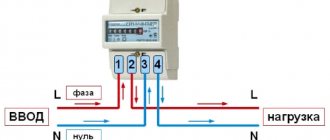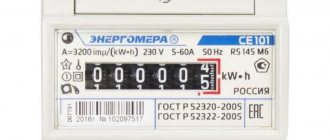In recent years, more and more often, electric meters are installed on a pole on the street. This is due to the fact that with this method of installing the metering device, it is much easier for employees of energy supply companies to take readings. After all, previously, even in private homes, electricity meters were installed indoors, and in order to gain access to them at the time readings were taken, it was necessary that someone was at home. Otherwise, it was impossible to obtain the data.
When installing meters outside the house, this problem solved itself. Moreover, modern street meters are specifically designed for this, and allow you to monitor the electricity consumed and clarify the readings taken at any time.
It should be noted that installing a metering device (for example, a three-phase meter on the street) requires compliance with certain rules. We will talk about the main ones in this article, and we hope that this information will be useful to you if you decide to install an electricity meter outside your residential premises.
Can they require that the electric meter be placed on a street pole?
Company employees cannot refer to the law in their demands for installing an electric meter on a pole. There is no such regulation in regulatory documents. Meanwhile, regulatory documents indicate the following rules for installing an electricity meter in homes:
- in a place protected from temperature changes (up to 0 degrees) and precipitation;
- fixation height 0.4 – 1.7 m;
- The owner of the facility bears full responsibility for the safety of the equipment.
Rice. 1 Installing an electricity meter on the street is a convenient solution for employees of the supplier company, but the law does not require it
The requirements of the supplier company’s employees are completely contrary to the norms:
- precipitation and winter temperatures reduce the service life and accuracy of the meter;
- installation at a high height prevents its normal use for humans;
- The owner of the facility bears the losses, since he is responsible for the serviceability of the equipment, which on the street breaks down faster.
Important: the street meter shows an error of 10% or more in the direction of the supplier.
How to connect a three-phase meter
There are three phases in a 380 V network, and electric meters of this type differ only in the large number of contacts. The inputs and outputs of each phase and neutral are located in pairs (see the diagram). Phase A enters the first contact, its output is on the second, phase B is the input on the 3rd, its output on the 4th, etc.
How to connect a three-phase meter
The rules and procedure are the same, only there are more wires. First we clean it, align it, insert it into the contact connector and tighten it.
The connection diagram for a 3-phase meter with a consumption current of up to 100 A is almost the same: input machine-meter-RCD. The only difference is in the distribution of phases to consumers: there are single- and three-phase branches.
Three-phase meter connection diagram
Installation of a meter on the street in dacha cooperatives and garden associations
Rice. 2 Installation of an electric meter on a dacha pole or in a private residential sector is carried out only by decision of the owners
In such companies, all decisions regarding the course of action or disposal of common property are made at a general meeting.
Important: if there is no meeting and, accordingly, no minutes, no one alone has the right to make decisions regarding organizational issues, much less demand their implementation.
Therefore, if the chairman of the company unreasonably demands the installation of an electric meter on the dacha pole, such claims can be ignored.
Reasons for replacement
In what cases is it necessary to replace electric meters?
The homeowner can replace the electric meter at his own discretion or in cases prescribed by law.
In general, there are four situations when the owner of a private residential building reinstalls electricity meters:
- repair of electrical networks and their modernization;
- planned dismantling;
- failure of the installed meter (breakage, incorrect readings);
- expiration of service life;
- desire to replace the device with a more modern model (for example, a multi-tariff device).
The main cases of replacing meters are associated with the expiration of the operational life of “ancient” devices, as well as insufficient power of those installed not so long ago. Usually the owner of the house understands himself that a meter that has served for three or four decades “no longer works.”
The fact is that a modern private house is simply “stuffed” with energy-intensive electronics:
- split systems;
- heating boilers;
- household electrical appliances;
- complex multi-level lighting;
- elements of the “smart home” system and much more.
Induction meters of outdated modifications, designed for a relatively gentle load, cannot cope with the situation and, as a result, “surprising” readings and knocking out plugs. The changing standards and regulations of energy suppliers should not be discounted.
What legislative acts can be referred to when refusing to transfer a meter?
Rice. 3 What do the laws indicate?
If you refuse to install an electric meter on the street in 2022, you can refer to the following legislative acts:
- Clause 1.5.27 PUE – installation of electrical equipment, selection of a location with optimal conditions for it;
- Clause 1.5.29 PUE - permissible installation height and rules for storing meters, for example, in special cabinets;
- Art. 210 of the Civil Code of the Russian Federation - responsibility for the safety and uninterrupted operation of equipment.
Government Decree No. 354 of 2011 also confirms the listed standards and does not indicate other parameters.
The legislative framework
Legislation on the installation of electric meters in individual houses
Before starting work, it is imperative to study the current regulations.
There are not many requirements, but deviations from the rules are fraught with sanctions from the supervisory authority. The procedure for installing electrical wiring and installing/replacing meters is regulated:
- Civil Code (Articles 541-544);
- “Rules for electricity metering” (Resolution of the Government of the Russian Federation dated November 2, 1995 No. 1087).
Only qualified specialists are entitled to service power consumption measuring instruments. Dismantling and replacement of equipment is carried out only with the permission of the service organization - clauses 4.3 - 4.7 of the Rules.
A package of documents required when moving an electric meter to the street
According to the procedure for installing an electric meter in a private house, careful preparation should be made for its dismantling and removal to the street. First of all, collect the appropriate package of documents:
- Before taking the equipment outside, you should request a standard contract from the supplier company and an act on the division of balance sheet ownership. This document will clearly outline the rights and responsibilities of each party. The document will indicate the series and number of the meter, its type, and the owner’s current account.
- Afterwards, it is important to draw up an application for permission to operate the equipment. It is drawn up at the company’s office; upon receipt, a control team will go to the specified address and check the correctness of the independent work carried out. The meter will be sealed and an act of approval will be generated.
Important: the act will indicate the degree of readiness of the equipment for operation and the cost of the company’s services. If the sealing is primary, then it is free.
Getting to know the PUE
This document contains regulatory legal acts of the USSR and a set of regulatory documentation of the Ministry of Energy.
Today, the 6th and 7th edition of the PUE is in effect throughout the Russian Federation. Moreover, in the latest edition there are some republished chapters.
The rules are a document that contains the following points regarding electrical installations:
- device description;
- principle of construction;
- special requirements regarding their systems (assemblies, elements and communications).
General procedure for installing an electric meter on the street
Rice. 4 Requirements for moving electricity meters to the street
If the owner of a summer cottage or private house decides to meet the requirements halfway, the rules for installing electricity meters on the street should be followed.
- Choose a location for the equipment - the first pole you come across will not work. The support for the meter must be rigid and durable.
- The owner must protect the device from weather conditions by placing it in a special cabinet with a window through which readings can be taken.
Important: the device can be operated at temperatures from 0 to +40 degrees.
- The cable must be reliably protected from kinks, bends and various damages. It is equipped with a reliable support.
Work on installing the meter is carried out in the following sequence:
- the electricity supply line is de-energized before operation;
- an automatic machine is installed in front of the device, and then an electric meter is connected behind it;
- Grounding must be installed for operational safety;
- House wiring is connected to the output contacts of the equipment.
Important: the first test switch-on must be performed to check the correct operation of the device.
A cabinet for an electric meter on the street will partially protect the device from damage
The closet is a separate topic of discussion. It is created and installed before installing the electric meter and in compliance with the rules:
- availability of burglary protection – reliable installation, fastening and installation of burglary protection;
- ensuring tightness to protect against moisture penetration;
- reliable protection from low temperatures through insulation; without it, the device will operate with errors in favor of the company.
Important: to ensure that the wire is reliably protected, an iron pipe is mounted to the box.
Types of circuit breakers
Electricity meter machines are distinguished according to several criteria:
- by the type of current in the main circuit;
- mechanical or motor control;
- installation method: the machines can be pulled out, be stationary or stuck into the wall;
- by type of release: they are magnetic, electronic, thermal and other types;
- body: may consist of separate parts or be solid, open or closed;
- the amount of current passed;
- the ability to disconnect the electrical circuit from a distance;
- protection that is triggered at critical voltage levels.
The sizes of machines for electricity meters can be different: designed to protect electrical networks in residential premises or large industrial buildings. Switches made in Russia and foreign made are installed in apartments.
Switches are divided into:
- differential;
- automatic;
- residual current devices. They protect against electric shock and prevent fire when electrical cables are damaged.
conclusions
If they are forced to install meters on poles, is this requirement legal? There are no rules according to which it would be possible to force the owner of a private house to install a meter on the street to his own detriment. He is the owner of the equipment and is responsible for the quality of its work. As a result of low temperatures, the device may refuse to work at all, or may show inflated data. In addition, such equipment can be stolen by vandals.
The energy company has no legal leverage over citizens in the event of a failure; they cannot cut off the power supply or sue the owner of the house. If the claims come from the chairman of the cooperative, then he must act on the basis of the minutes of the general meeting. The document gives him the authority to demand that the owners of the site comply with the rules adopted by them.
If the owner of the site decides to move the meter outside, he must comply with all the requirements for its equipment, connection and startup.
Order a free legal consultation
What are the benefits
Placing a meter on the street is beneficial not only for the energy company, but often for the customers themselves. Thanks to the presence of special radio channels in the operating system of new electric meters, the consumer does not need to leave the house to check the relevant criteria.
Information about the consumption of electrical energy in the interface of a special remote control, which excludes the visit of an inspection commission to the home of an individual.
Thanks to technological progress, company employees have the ability to remotely take meter readings of your device without the need for the presence of the meter owner at its location.
Attention! A measure to protect an electric meter attached to a support on a street area is to install a special shield around it. It is not only installed at the stage of initial installation of the meter, but is also equipped with a transparent window for more comfortable reading of the device.
What to do after the transfer
Installation of the device at a new place of operation is carried out by a representative of energy sales. But the owner of the site needs to ensure that the device is put into operation correctly and that all necessary documents are completed:
- In order for the meter to be put into operation, you need to submit an application to the energy company. It indicates the consumer’s passport details, his contacts, and the number of the contract with the supplier.
- A company representative will fill out the documents and indicate the arrival time of the specialist to install the seal. The first sealing should be free.
- After putting the meter into operation, you need to make sure that it is reliably protected by a special shield with a transparent window for reading readings.
At whose expense is the electric meter changed in a private house?
The answer to this question has already been discussed above. In a situation where a citizen, in relation to residential premises, has a triad of powers of ownership, use and disposal, then all the costs of installing metering devices fall on his shoulders.
The same applies to owned apartments. If the metering devices are common to the building, then all owners of apartments located in an apartment building must make a cash contribution to replace the electric meter.
Choosing a new electricity meter
The law does not establish any requirements for a specific company or brand of electric meter. Therefore, a citizen has the right to purchase absolutely any device. You should pay attention to whether there are quality certificates, whether the meter has passed the necessary tests, etc. You can install either a single-phase device or a meter that has a comprehensive function for measuring the amount of household services consumed.
PRO new building 7 (499) 450-27-46 (Moscow)
- the service life has long expired (according to the passport data);
- the date of the last state verification has expired;
- there is damage to the housing or the viewing window;
- the counting mechanism is faulty;
- the seal is missing or broken;
- indication error (accuracy class) exceeds 2.5.
Since any household electricity meter is located immediately after the introductory machine, it should be considered the property of the apartment owner, who bears full responsibility for it. So you will have to bear all the costs of replacing an outdated or faulty meter.
Is it worth giving up?
According to legal regulations, electricity meters are placed outside only with the consent of the owner. The basis for submission to the SNT may be a collective decision made at a general meeting.
Initially, many may perceive such an innovation critically, fearing for the safety of their property. But you also need to take into account the benefits that a change in the location of the device will provide. The controller will no longer bother you with monthly visits.
The indicator data will be sent to the settlement center on time, this eliminates the accrual of penalties and fines, and the occurrence of any misunderstandings. The device is reliably protected by a special shield against hacking and theft. For SNT members, such placement of the meter can also have significant advantages.











